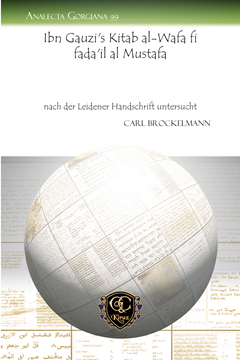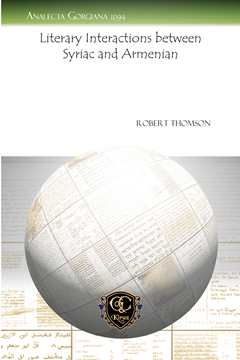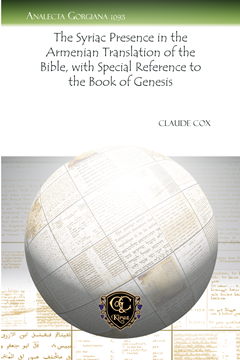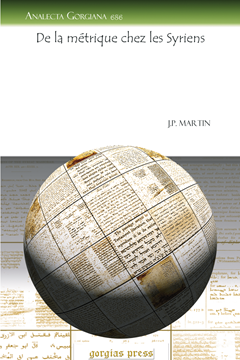Analecta Gorgiana
Analecta Gorgiana is a collection of long essays and short monographs which are consistently cited by modern scholars but previously difficult to find because of their original appearance in obscure publications. Carefully selected by a team of scholars based on their relevance to modern scholarship, these essays can now be fully utilized by scholars and proudly owned by libraries.
Narsai le docteur et les origines de l'école de Nisibe, d'après la chronique de Barḥadbešabba
Translated and Annotated by J.-B. Chabot
Series: Analecta Gorgiana 490
ISBN: 978-1-60724-968-9
This volume contains Chabot’s notice of a fragment published by Mingana from Barhadbeshabba dealing with Narsai and the School of Nisibis. Chabot offers a French translation of the text and a summary questioning its historical value.
$36.00 (USD)
Homélie de Narsès sur les trois Docteurs Nestoriens
Edited and Translated by Paulin Martin
Series: Analecta Gorgiana 475
ISBN: 978-1-60724-931-3
In this work, Martin offers the Syriac text, with an annotated French translation, of Narsai’s poem on the three doctors of the Church of the East: Diodore of Tarsus, Theodore of Mopsuestia, and Nestorius.
$57.00 (USD)
Ibn Gauzi’s Kitab al-Wafa fi fada’il al Mustafa
nach der Leidener Handschrift untersucht
Series: Analecta Gorgiana 99
ISBN: 978-1-60724-023-5
This investigation of Abu-al-Faraj Ibn al-Jawzi’s al-Wafa bi Fada'il al-Mustafa, according to the Leiden manuscript by one of Germany’s foremost Semiticists, is essential reading for anyone interested in Arabic history and literature. Ibn al-Jawzi was a twelfth-century jurist and perhaps the most prolific writer in the history of Arabic literature. Al-Wafa bi Fada'il al-Mustafa (Detailed Accounts of the Chosen Prophet), is a large work on the biography of the prophet Muhammad. In this manuscript study, Brockelmann analyzes several aspects of this composition, including citations of this work by other notable Islamic writers.
$45.00 (USD)
Literary Interactions between Syriac and Armenian
Series: Analecta Gorgiana 1094
ISBN: 978-1-4632-0142-5
Thomson surveyed Syriac literary influence on Armenian Christianity from the time of early missionary activity to the middle ages. Evidence suggests that Armenian Christians are greatly indebted to Syriac contributions on sainthood and theology, but less so for historical writing.
$34.00 (USD)
The Shorter Syriac-Armenian Glossary in Ms. Yale Syriac 9
Part 1
Series: Analecta Gorgiana 1092
ISBN: 978-1-4632-0140-1
Takahashi and Weitenberg provide the history and linguistic analysis of Ms. Yale Syriac 9. Only three such Syriac-Armenian lexica are known to survive. The glossary is classified as the Western branch of Modern Armenian, attributed to Dialect Group 5.
$34.00 (USD)
De l’alphabet sogdien
Series: Analecta Gorgiana 838
ISBN: 978-1-61143-309-8
This paper, reprinted from the Journal Asiatique, provides a handy introduction to the Sogdian alphabet used for Buddhist texts in Central Asia.
$35.00 (USD)
The Stag-Messenger Episode
By M. B. Ogle
Series: Analecta Gorgiana 765
ISBN: 978-1-61143-143-8
This article by M.B. Ogle is a demonstration of how the theory that the stag-messenger episode of Medieval literature is Celtic in origin has erred, and proposes it was of oriental provenance.
$37.00 (USD)
The Performance of Normativity
Mormons and the Construction of an American Masculinity
Series: Analecta Gorgiana 1069
ISBN: 978-1-4632-0116-6
This paper examines the construction of masculinity among male members of the Church of Jesus Christ of Latter-day Saints (Mormons) and its underlying historical factors.
$36.00 (USD)
The Palestinian Version of the Holy Scriptures
Edited and Translated by George Henry Gwilliam; In Collaboration With Ernest Nathaniel Bennett
Series: Analecta Gorgiana 528
ISBN: 978-1-61719-186-2
This work consists of five leaves of the old Syriac version of the Bible, in the Palestinian dialect. Included are images of some of the leaves, Syriac text, English translation, notes, and a essay on the underlying Greek text.
$46.00 (USD)
The Temple of the Kings
At Abydos (Sety I.)
By Algernon Saint George Caulfeild; In Collaboration With H. Lawrence Christie; Contribution by W. M. Flinders Petrie
Series: Analecta Gorgiana 594
ISBN: 978-1-61719-486-3
This work consists of the first architectural description of the Temple of Seti I at Abydos, reporting the first full excavation of 1902.
$48.00 (USD)
The Monks of Rabban Hormizd
Series: Analecta Gorgiana
ISBN: 978-1-61143-585-6
Arthur Vaschalde provides a brief survey and translation of a manuscript containing historical details about the Monastery of Rabban Hormizd in Iraq.
$33.00 (USD)
Der alte Anfang und die upsprünglich Form von Cyprians Schrift Ad Donatum
Series: Analecta Gorgiana 602
ISBN: 978-1-61719-433-7
This much-cited essay contains the third century Christian leader Cyprian's letter to his friend Donatus written shortly after his conversion.
$33.00 (USD)
The Syriac Presence in the Armenian Translation of the Bible, with Special Reference to the Book of
By Claude Cox
Series: Analecta Gorgiana 1093
ISBN: 978-1-4632-0141-8
Syriac and Armenian Christians interacted regionally and theologically. This paper investigates whether it is thus a viable proposition to deduce Syriac readings from Armenian biblical translations. Cox concludes on a case-basis because extensive use of a similar source text remains questionable.
$36.00 (USD)
Priestly Power that Empowers
Michel Foucault, Middle-Tier Levites, and the Sociology of ‘Popular Religious Groups’ in Israel
Series: Analecta Gorgiana 1084
ISBN: 978-1-4632-0131-9
Christian analyzes priestly social dynamics in-depth as they develop through tribal history and specialization of tasks. He focuses on middle-tier Levites as their skills and specialized knowledge place them in upper classes but their work relegates them as intermediaries.
$51.00 (USD)
The Contested History of a Book
The German Bible of the Later Middle Ages and Reformation in Legend, Ideology, and Scholarship
Series: Analecta Gorgiana 1079
ISBN: 978-1-4632-0126-5
This paper explores the common misconception that vernacular translations of the Bible were not available prior to Luther. In fact, Luther may have relied on these to accomplish his own work toward what became a more preferable translation.
$39.00 (USD)
Syriac into Armenian
The Translations and their Translators
Series: Analecta Gorgiana 1091
ISBN: 978-1-4632-0139-5
This article describes the historical development of Armenian translations of Syriac literature from the 5th century, Intervening- and Clinician Periods. Significant works and figures are highlighted.
$36.00 (USD)
A Perfectly Broken Acrostic in Nahum 1?
By Thomas Renz
Series: Analecta Gorgiana 1088
ISBN: 978-1-4632-0135-7
Renz discusses the acrostic poetic form of Nahum 1. The alphabetic sequence is interrupted by YHWH’s actions, conveying that this poem is a communication about divine order and chaos. This sets the tone for the flood motif in Nahum 2.
$37.00 (USD)
Persian Period Jerusalem and Yehud
A Rejoinder
Series: Analecta Gorgiana 1078
ISBN: 978-1-4632-0125-8
The author responds to criticism against his prior publications, when his conclusions were based foremost on the relevant archaeological findings. It is a debate between methodologies used by archaeology and the assumptions of textual analysis within biblical scholarship.
$33.00 (USD)
Studies in Manichaeism
Series: Analecta Gorgiana 903
ISBN: 978-1-61143-497-2
This work is a detailed study of Manichaeism from findings of a 1903 study in East Turkestan.
$33.00 (USD)
Chrestomathia Chaldaica, varios textos exhibens
Aramaic Chrestomathy
By J.J. Marcel
Series: Analecta Gorgiana 698
ISBN: 978-1-61719-674-4
In this early reading book for Aramaic (that is, not Syriac), J.J. Marcel provides a few texts from the Bible together with an Aramaic-Latin glossary.
$52.00 (USD)
Notice sur les manuscrits syriaques conservés dans la bibliothèque du Patriarcat chaldéen de Mossoul
By Addai Scher
Series: Analecta Gorgiana 696
ISBN: 978-1-61719-672-0
In the present work, Scher covers the Syriac (and some Arabic) manuscripts then located at the Chaldean Patriarchal Library in Mosul, which possessed a broad and rich collection. An index of authors and anonymous works concludes the catalog.
$38.00 (USD)
La lettera di Simeone vescovo di Bêth-Arsâm sopra I martiri omeriti
Edited and Translated by Ignazio Guidi
Series: Analecta Gorgiana 689
ISBN: 978-1-61719-665-2
Guidi, in this long article, presents an edition and thoroughly annotated Italian translation of the Syriac “Letter on the Himyarite Martyrs,” which deals with the persecution of Christians in Nagran, from author and bishop, Simeon of Beth Arsham.
$41.00 (USD)
De la métrique chez les Syriens
By J.P. Martin
Series: Analecta Gorgiana 686
ISBN: 978-1-61719-637-9
In this lengthy essay on the subject of Syriac meter, Martin begins by reviewing the previous scholarship on the subject and then edits the section on meter from Jacob bar Shakko’s Book of Dialogues, with annotated French translation.
$47.00 (USD)
St. Ephraemi Syri Theologia quantum ex Libris Poeticis Cognosci Potest Explicatur
Ephrem’s Theology as Found in his Poetry
By Albert Haase
Series: Analecta Gorgiana 584
ISBN: 978-1-61719-543-3
This study is set as a theological look at Ephrem the Syrian. After a general introduction, the author systematically examines a number of theological topics based on Ephrem’s poetry. The Syriac passages cited are also translated.
$40.00 (USD)
Die Scholien des Theodor Bar Kônî zur Patriarchengeschichte (Genesis XII-L)
Edited with an Introduction by Martin Lewin
Series: Analecta Gorgiana 665
ISBN: 978-1-61719-614-0
This volume includes a critical edition, with notes, of part of the Scholia-Commentary of Church of the East author Theodore bar Koni (fl. end of the 8th cent.), namely the part on the patriarchal narratives in Genesis.
$47.00 (USD)

























